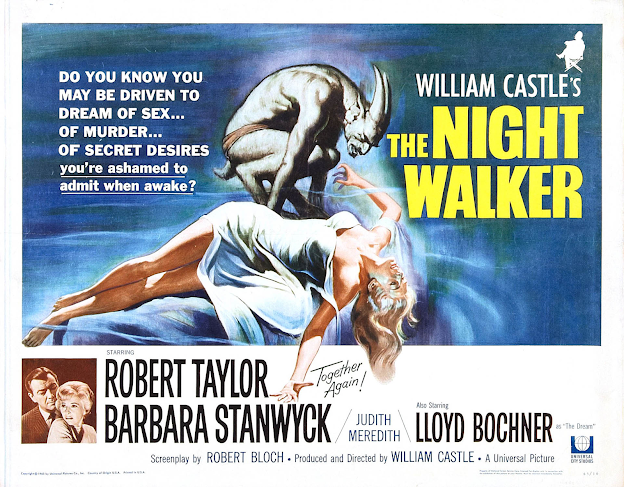Famous for
seven movies made between 1958 and 1962. Each with a "GIMMICK" to draw in the
audience. William Castle’s story actually goes back to 1927 and the original
Broadway Play “Dracula”.
Obviously I will not be going into the detail of every
work he was involved in. 24 as Producer, 65 as Director, 18 as an Actor and 7 as the writer, but when we come to those seven films, which I saw
when they originally opened, I have some personal experiences to relate about
those fun "Gimmicks".
THANK YOU COUNT DRACULA
THANK YOU COUNT DRACULA
William Schloss, Jr. was born on
April 24, 1914 in New York City. His parents were Saidie (Snellenberg) and
William Schloss. His mother passed away when the boy was nine and his father
followed her a year later. William lived with his older sister until a
vampire intervened.
It was in 1927 at the age of 13 that Bela Ferenc Dezo Blasko entered young William’s life and made a lasting impression on the teen. Schloss, Jr. went to see the play “Dracula” starring Blasko under his stage name of Bela Lugosi over and over and over again. According to his autobiography “Step Right Up! I’m Gonna Scare the Pants off America”
It was in 1927 at the age of 13 that Bela Ferenc Dezo Blasko entered young William’s life and made a lasting impression on the teen. Schloss, Jr. went to see the play “Dracula” starring Blasko under his stage name of Bela Lugosi over and over and over again. According to his autobiography “Step Right Up! I’m Gonna Scare the Pants off America”
I knew then what I wanted to do with my life – I wanted to scare the pants off of the audienceHowever, it wasn’t going to be that easy and would take a little time.
The first step had come from
meeting Bela Lugosi and the start of the friendship between the two. The 45 year old actor recommended the young boy for the position of Stage Manager on the road
trip of the play. As a result 15 year old William Schloss, Jr changed his name to the more American sounding William Castle, dropped out of school and never looked back.
The choice of his new last name wasn't to far a stretch to create. "Schloss" was German for "Castle". The idea of changing his name to a more "American" sounding one was a regular occurrence with young people at the time with foreign sounding names. The did it to make it easier to assimilate into the United States working community without a fear of prejudice.
His friendship with Bela Lugosi led to William Castle eventually working on Broadway, The term "Gofer" truly applied to the young man. Castle was doing everything from set design to acting and whatever fell in between. There is a story that he got his first acting job by passing himself off as the son of Movie Mogul Samuel Goldwyn.
William Castle’s first directing position was at the age of 18 in a production of “Dracula” of all things. By that time the traits of the “Gimmick King” were already forming. Leading to his next related move sometime around his 21st birthday, 1935, which topped them all so far.
ORSON WELLES AND ADOLPH HITLER
There is a Yiddish word that defined the young William Castle CHUTZPAH! Defined by the Merriam-Webster Dictionary as:
The choice of his new last name wasn't to far a stretch to create. "Schloss" was German for "Castle". The idea of changing his name to a more "American" sounding one was a regular occurrence with young people at the time with foreign sounding names. The did it to make it easier to assimilate into the United States working community without a fear of prejudice.
His friendship with Bela Lugosi led to William Castle eventually working on Broadway, The term "Gofer" truly applied to the young man. Castle was doing everything from set design to acting and whatever fell in between. There is a story that he got his first acting job by passing himself off as the son of Movie Mogul Samuel Goldwyn.
William Castle’s first directing position was at the age of 18 in a production of “Dracula” of all things. By that time the traits of the “Gimmick King” were already forming. Leading to his next related move sometime around his 21st birthday, 1935, which topped them all so far.
ORSON WELLES AND ADOLPH HITLER
There is a Yiddish word that defined the young William Castle CHUTZPAH! Defined by the Merriam-Webster Dictionary as:
Supreme Self-Confidence: Nerve, Gall
Castle was able to obtain Orson
Welles’ unlisted phone number and called him. At the time Orson was leaving for
RKO to start work on a little film called “Citizen Kane". Welles was open to the
young man’s proposition of leasing the Stone Creek Theater in Connecticut that he owned.
William Castle now had had a playhouse, but no play or cast.
William Castle now had had a playhouse, but no play or cast.
Next he hired out of work German-American
actress Ellen Schwanneke as his star, but discovered that under
current theater guild regulations. German-born actors could only appear in plays
originally performed in Germany. So William Castle claimed Schwanneke was hired
to appear in “Das ist nicht fur Kinder (Not for Children) a German play that of
course did not exist.
So now he had a leading lady, a theater, but still no play.
Then almost on cue Ellen Schwanneke received an invitation from Nazi Germany. They wanted her to return to Munich and once again perform on stage in her native country. Which of course she did not want to do. William Castle’s publicity aptitude kicked into high gear and suddenly the papers were running a story portraying Schwanneke as:
WORKING FOR "KING COHN"
So now he had a leading lady, a theater, but still no play.
Then almost on cue Ellen Schwanneke received an invitation from Nazi Germany. They wanted her to return to Munich and once again perform on stage in her native country. Which of course she did not want to do. William Castle’s publicity aptitude kicked into high gear and suddenly the papers were running a story portraying Schwanneke as:
The girl who said no to Hitler.With all this publicity William Castle needed that nonexistent play. So over the next 48 hours the young entrepreneur wrote one himself. William Castle then added the crowning touch, one late night, by painting swastikas all over the exterior of the Stone Creek Theater as if it had been vandalized. Both Castle and Schwanneke being Jewish his publicity trick worked like a charm.
WORKING FOR "KING COHN"
William Castle was on his way to
Hollywood and the movie business at the old age of 23. He found work for Co-Founder, President and Production Head Harry "King" Cohn at Columbia Pictures Studios. That first year, 1937, saw William Castle appearing in three feature films starting with the Virginia Bruce, Kent Taylor and Walter Brennan film "When Love Is Young".

Castle's non-screen credited role was described as a "Reporter", but at least he was in motion pictures and learning the business from the inside by being willing to do anything.
Castle’s first director assignment was an 9 minute short subject tour of "Coney Island" in 1939. 1940 saw William Castle in two more non-screen credited acting roles and then in 1942, without on screen credit, Castle was given his first writing assignment. "King" Cohn wanted him to turn Jack London's "North to the Klondike" into a story outline for the screenplay writers. This forgotten movie is memorable for two actors. Both Lon Chaney, Jr. and Evelyn Ankers moved to Universal Studios for their next motion picture 1942's "The Wolfman" after completing this Columbia Pictures feature.

Castle's non-screen credited role was described as a "Reporter", but at least he was in motion pictures and learning the business from the inside by being willing to do anything.
Castle’s first director assignment was an 9 minute short subject tour of "Coney Island" in 1939. 1940 saw William Castle in two more non-screen credited acting roles and then in 1942, without on screen credit, Castle was given his first writing assignment. "King" Cohn wanted him to turn Jack London's "North to the Klondike" into a story outline for the screenplay writers. This forgotten movie is memorable for two actors. Both Lon Chaney, Jr. and Evelyn Ankers moved to Universal Studios for their next motion picture 1942's "The Wolfman" after completing this Columbia Pictures feature.
Back to short subjects with one for the "Office
of War Information" and distributed by the "War Activities Committee of the
Motion Picture Industry". Released August 19, 1943 “Black Marketing" is pure propaganda under the cover of an educational film. The 10 minute short
warns American civilians against buying un-rationed foodstuffs and materials. William Castle was moved by Harry Cohn to full length feature films and his first was "The Chance of a Lifetime". Cohn thought cheap and liked making film series with recurring characters, actors and even sets.
"Chance of a Lifetime" was the sixth motion picture in a series based upon "Boston Blackie". "Blackie" was a notorious, but honorable jewel thief and had been played by actor Chester Morris since the first Columbia Pictures film in 1941. A total of 16 movies would be in the series.
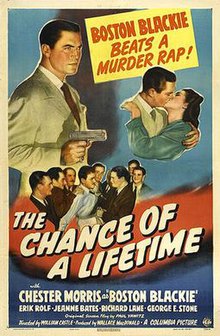
It's hard to read but the last line of small print of the above poster for the film reads:
Directed by WILLIAM CASTLEIn 1944 Columbia Pictures acquired the rights to the popular radio program “The Whistler” and William Castle was given the job of directing the movie.

On April 29, 1944 for the New York Times film critic Bosley Crowther panned the film stating:
Such is the miserable expedient to which Richard Dix is reduced in this weary, illogical imitation of an Alfred Hitchcock (plus an early Fritz Lang) film. For an hour or thereabouts he starts and stumbles just out of reach of a relentless J. Carrol Naish, who first has the original intention of of frightening Mr. Dix to death. Along that line, the producers might have made a likely serio-comic film. but they change Mr. Naish's mind to quickly and send him---and the picture---in for a real kill. And so we get the routine spectacle of a dragged-out killer--and victim chase, all very serious and phony--and consequently very dull.Columbia Studio head Harry Cohn loved that description and the film would be followed by seven more for a total of eight. Three more would be directed by William Castle whom the "King" was very pleased with.
On March 2, 1945, lent out by Cohn, Monogram
Pictures released the film “Dillinger”. The film has a bigger reputation than
it deserves. However, the music was by an up and coming composer Dimitri
Tiomkin. A much talked about smoke filled bank robbery scene was actually
lifted from Fritz Lang’s 1937 “You Only Live Once”. The screenplay by
Philip Yordan was nominated for an Academy Award making it the only Oscar
nomination Monogram Studios would ever have.
_02.jpg)
I mention this film for that screenplay which was basically written by the non-screen credited William Castle. Who received no recognition by the "Academy of Motion Picture Arts and Sciences", Monogram Studios, or Philip Yordan. Head Studio writer, for his contribution.
Two years later found William Castle as an Associate Producer on Orson Welles’ “The Lady from Shanghai.” He also co-wrote the motion picture with Wells without on screen credit.
_02.jpg)
I mention this film for that screenplay which was basically written by the non-screen credited William Castle. Who received no recognition by the "Academy of Motion Picture Arts and Sciences", Monogram Studios, or Philip Yordan. Head Studio writer, for his contribution.
Two years later found William Castle as an Associate Producer on Orson Welles’ “The Lady from Shanghai.” He also co-wrote the motion picture with Wells without on screen credit.
I always wondered what Orson Welles felt about Castle defacing his Playhouse as publicity for that play he wrote? ,
Nine more assigned director positions. on pictures with titles such as "Crime Doctors Man Hunt", part of another Columbia Pictures film series, and "Texas, Brooklyn and Heaven" a romantic comedy starring Guy Madison and William Castle worked on “Johnny Stool Pigeon” released September 2, 1949, for Universal Studios.
.jpg)
Nine more assigned director positions. on pictures with titles such as "Crime Doctors Man Hunt", part of another Columbia Pictures film series, and "Texas, Brooklyn and Heaven" a romantic comedy starring Guy Madison and William Castle worked on “Johnny Stool Pigeon” released September 2, 1949, for Universal Studios.
.jpg)
This film noir was about a narcotics agent who convinces an
ex-con, played by Howard Duff, to go undercover to expose a heroin ring. Besides Duff the film
has several other Universal Studio contract players such as Shelley Winters,
Dan Duryea, John McIntire, Leif Erickson, John McIntire, Charles Drake and Anthony Curtis before he changed
that stage name to Tony Curtis. Which was still better than Bernard Schwartz.
“Johnny Stool Pigeon” was followed by a group of low budget detective thrillers/ Then in 1951 Columbia switched William Castle to a combination of Westerns and Historical semi-Biblical adventure movies. For a prospective these films reflected what was considered "Safe" motion pictures during the Communist Investigation of the Motion Pictures Industry by both the "House Committee on Un-American Activities" and in the Senate Joseph McCarthy.
Castle's first feature of this period starred McDonald Carey and Alexis Smith in “Cave of Outlaws” released November 1951.

That film was followed by seven more Westerns with such titles as: “Conquest of Cochise”, “The Law vs Billy the Kid”, "Fort Ti" and “Jessie James vs the Daltons”. The last two filmed in 3-D as part of the popular movie craze at the time.


I wrote an article about this 3-D motion picture period at the following link. Oh, the stills are in 3-D, if you have the the glasses.
http://www.bewaretheblog.com/2015/08/third-dimension-golden-age-of-3-d.html
Castle's first feature of this period starred McDonald Carey and Alexis Smith in “Cave of Outlaws” released November 1951.

That film was followed by seven more Westerns with such titles as: “Conquest of Cochise”, “The Law vs Billy the Kid”, "Fort Ti" and “Jessie James vs the Daltons”. The last two filmed in 3-D as part of the popular movie craze at the time.


I wrote an article about this 3-D motion picture period at the following link. Oh, the stills are in 3-D, if you have the the glasses.
http://www.bewaretheblog.com/2015/08/third-dimension-golden-age-of-3-d.html
In all William Castles directed 16 motion pictures in a four year run from 1951 through September 1955. Castle’s westerns were
interspersed with such great "Shlock" titles as: “Slaves of Babylon” starring Richard Conte and Linda Christian
Then there was his “Serpent of the Nile” that featured "Flaming Red Head", actual publicity line, Rhonda Fleming wearing a coal black wig as "Cleopatra", Raymond Burr as "Mark Antony" and "William Lundigan as "Lucilius".
In an non-screen credited role Julie Newmar appears as a dancer completely covered in gold paint.


Then there was his “Serpent of the Nile” that featured "Flaming Red Head", actual publicity line, Rhonda Fleming wearing a coal black wig as "Cleopatra", Raymond Burr as "Mark Antony" and "William Lundigan as "Lucilius".
In an non-screen credited role Julie Newmar appears as a dancer completely covered in gold paint.


Four more films later which
included the excellent Glenn Ford South American Western “The Americano” in 1955. We now come to the first of a
series of films that raised William Castle from a contract director to an
independent director. Who would translate his boyhood dream
I mean who really was ever scared by a William Castle motion picture?
THE GIMMICKS KING
To scare the pants off audiencesinto a reality of sorts.
I mean who really was ever scared by a William Castle motion picture?
THE GIMMICKS KING
I know my readers are familiar
with the next set of films. but if you
will permit I will give you my first impressions of Castle’s “Gimmicks”. Such as “Emergo”
and being able to determine the fate of “Mr. Sardonicus”. As I saw each film
the first weekend they originally opened with all those lovely “Gimmicks”
in place.
William Castle’s first “Gimmick”
film was the suspenseful "MACABRE". The picture really wasn’t a horror movie, but an
old style thriller of the race against time variety. "Doctor Rodney Barrett’s" wife and her sister had been murdered in the past and some believe he's their killer. Now his young daughter has been buried alive in a
coffin by an unknown maniac with just five hours to live. Is this all connected with the "Wetherby" fortune?
The idea of using a "Gimmick" to lure an audience into a movie theater could be considered to have actually started with 1927's "The Jazz Singer". When by accident, 17.25 minutes into the picture, the "Vitaphone" device, designed for adding music, picked up five spoken words from star Al Jolson. Then in a couple of other scenes some more words and the Warner Brother's publicity department screamed out:
Other motion pictures had interesting firsts, but not really a true "Gimmick" as a draw. Besides these were never promoted as such. Examples are the first actor playing a major role as twins seen in the same frames talking to each other, or the opening of "The Wizard of Oz". The farm sequence was tinted in sepia tones, but as "Dorothy" opens the door of her house to see "Oz". The picture turns into bright Technicolor. There were also new developments in movie technology like "CinemaScope" and "Stereophonic Sound" and you could call these "Gimmicks". When they first appeared in a sense.
However it was William Castle who first used what was an actual "Gimmick" as a draw and publicized it. The Merriam-Webster Dictionary defines the word "Gimmick" used by Castle as:
William Castle the "Promoter and Chief" needed a way to make "MACABRE" larger than it was. Thinking that through led him to the prestigious insurance firm of "Lloyd’s of London" founded in 1686. They agreed to insure anyone who could be medically certified to have died of fright from the film for One Thousand Dollars.
The idea of using a "Gimmick" to lure an audience into a movie theater could be considered to have actually started with 1927's "The Jazz Singer". When by accident, 17.25 minutes into the picture, the "Vitaphone" device, designed for adding music, picked up five spoken words from star Al Jolson. Then in a couple of other scenes some more words and the Warner Brother's publicity department screamed out:
JOLSON TALKS!As audiences went to hear those few words that ended silent motion pictures.
Other motion pictures had interesting firsts, but not really a true "Gimmick" as a draw. Besides these were never promoted as such. Examples are the first actor playing a major role as twins seen in the same frames talking to each other, or the opening of "The Wizard of Oz". The farm sequence was tinted in sepia tones, but as "Dorothy" opens the door of her house to see "Oz". The picture turns into bright Technicolor. There were also new developments in movie technology like "CinemaScope" and "Stereophonic Sound" and you could call these "Gimmicks". When they first appeared in a sense.
However it was William Castle who first used what was an actual "Gimmick" as a draw and publicized it. The Merriam-Webster Dictionary defines the word "Gimmick" used by Castle as:
A trick, or device used to attract business or attention: a marketing device
William Castle the "Promoter and Chief" needed a way to make "MACABRE" larger than it was. Thinking that through led him to the prestigious insurance firm of "Lloyd’s of London" founded in 1686. They agreed to insure anyone who could be medically certified to have died of fright from the film for One Thousand Dollars.
Today that doesn’t sound like
much money, but when you figure the movie came out for my 12th birthday in
October of 1958. At the time you could buy a new three bedroom house for
approximately $30,000, a new car for $1,967 and the average yearly income was
only $4,650. One Thousand Dollars was truly a whole lot of money and today, in 2017, would equate to $8,501 dollars.


For my birthday I waited in a line that went down a city block and around the corner. This was at the now long gone Van Nuys Theater, in Van Nuys, California, a suburb of Los Angeles, in the San Fernando
Valley. I paid for my ticket and had my first experience with would become CASTLE-MANIA,
Standing next to the ticket taker was another person giving me a copy of my Insurance Policy. In a corner of the lobby was a table with medical supplies on it. Next to that was an ambulance gurney with an nurse, or let’s be honest a person hired by Castle to impersonate one. What was even more impressive to 12 year old Lloyd was that the film actually was very well done and that twist ending got me. Oh, and after the film faded to black Castle’s voice asked you not to reveal the ending to anyone.

Standing next to the ticket taker was another person giving me a copy of my Insurance Policy. In a corner of the lobby was a table with medical supplies on it. Next to that was an ambulance gurney with an nurse, or let’s be honest a person hired by Castle to impersonate one. What was even more impressive to 12 year old Lloyd was that the film actually was very well done and that twist ending got me. Oh, and after the film faded to black Castle’s voice asked you not to reveal the ending to anyone.

Before “Dear Vincent” invites his
guests for an evening of fun and murder. Let me explain something you may not
have been aware of, or not thought of about the next two William Castle films.
They could only work in a Walk-in movie theater and not a Drive-in theater. So Castle made two cuts of each film as a large percentage of the youth market preferred Drive-in's. Which meant the gimmicks were out, BUT before the “HOUSE ON HAUNTED HILL” actually opened the word about the difference was also out. Not to say 50’s teens didn’t go to a Drive-in where the film played, but honestly, again, who went to see the movie? Ever wondered how many teens you could get into a VW Bug for that dollar a car-load price? Another story and I’m drifting here.
They could only work in a Walk-in movie theater and not a Drive-in theater. So Castle made two cuts of each film as a large percentage of the youth market preferred Drive-in's. Which meant the gimmicks were out, BUT before the “HOUSE ON HAUNTED HILL” actually opened the word about the difference was also out. Not to say 50’s teens didn’t go to a Drive-in where the film played, but honestly, again, who went to see the movie? Ever wondered how many teens you could get into a VW Bug for that dollar a car-load price? Another story and I’m drifting here.
Once more I stood in line at the
Van Nuys Theater. When I entered to take my seat. In the far right corner, by
the movie screen and the emergency exit door, was a curtained area that did not
belong there with a wire line coming out and over the seats. The other end of
this wire was attached to the left side wall several rows behind mine by the
door I had just entered through. Already the theater staff were having problems
with kids gathering around that curtain to look up to see what it might hold
and of course out of curiosity I joined them.

Below the opening scene of a superimposed Vincent Price inviting the theater audience to meet his guests and enjoy a nice evening in the house he rented for a strange diner party with deadly party favors.

The film kept our attention and that scene with the blind house keeper appearing out of nowhere really did it's job. Finally keeping Castle’s promise about what he would do to our pants. Yet, like the other kids in the audience I still wondered when whatever was behind that curtain would show itself.
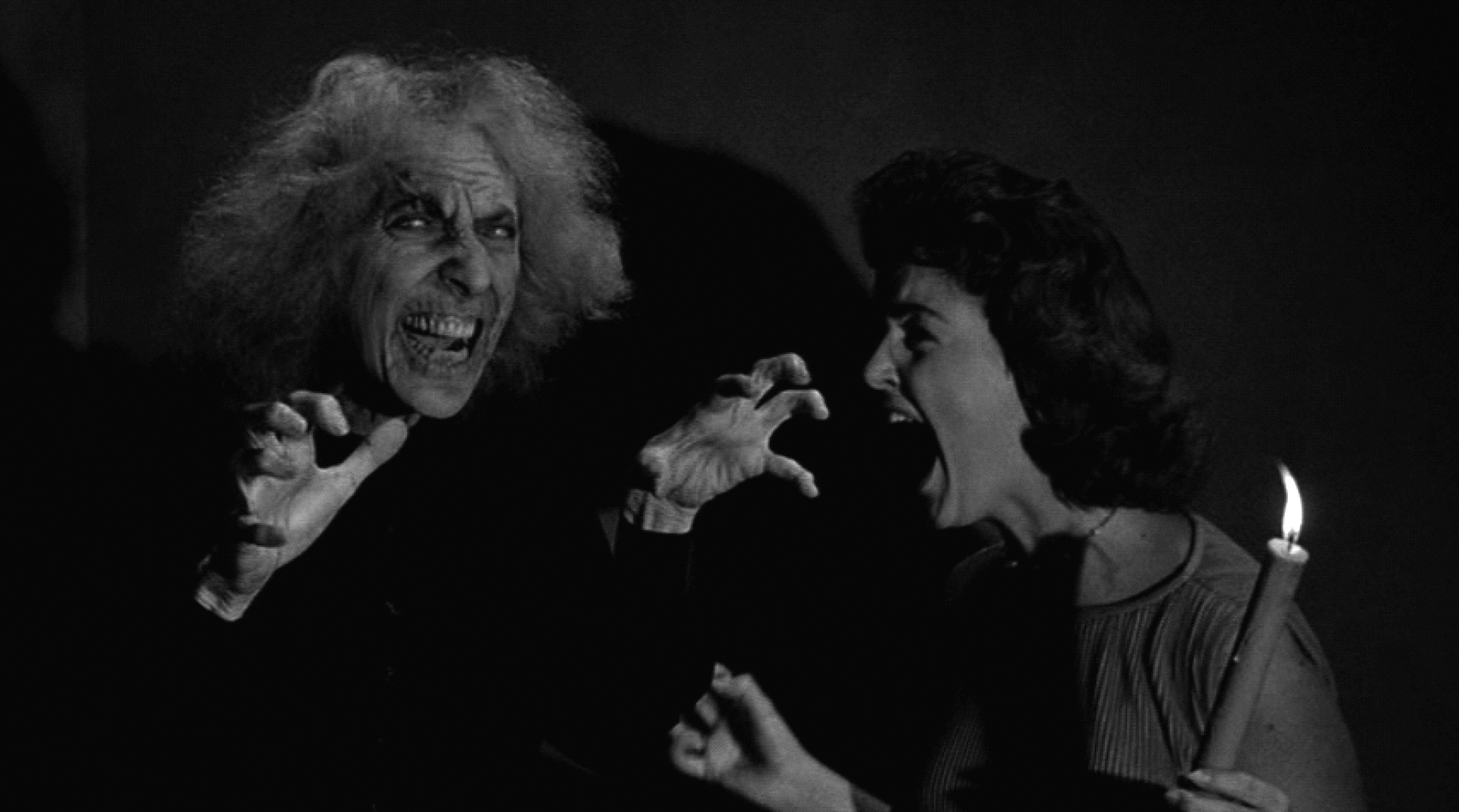
Then came the scene were Price’s
adulteress wife thought he was dead in the basement. She enters the room with
the vat of acid and slowly out of it rises her husband’s skeleton speaking to
her. She slips and falls into the acid vat, but the skeleton keeps coming and
the screen went white and from that right hand corner of the Van Nuys Theater
“Emergo” kicked in.
A lighted plastic skeleton with flaming red eyes moved over the audience and I don’t remember if we laughed, or just stared. The skeleton reached a point over the center of the audience and then started backing up and returned behind the curtain. On screen Vincent Price, on cue, emerges from a corner where he was hiding. Revealing that the skeleton that caused his wife’s death was really some giant marionette.


A lighted plastic skeleton with flaming red eyes moved over the audience and I don’t remember if we laughed, or just stared. The skeleton reached a point over the center of the audience and then started backing up and returned behind the curtain. On screen Vincent Price, on cue, emerges from a corner where he was hiding. Revealing that the skeleton that caused his wife’s death was really some giant marionette.

A problem developed for the
theaters showing the film in “Emergo”. Popcorn boxes and Junior Mints made fine
objects to toss at the skeleton once word of it got out. Some theaters either
stopped using the system, took it down, or they only used it for evening
performances when parents escorted their children.
Actually “Emergo” and “Percepto”
were basically used only during the initial run as they took time and money,
partly on the part of the theater owners, to set them up. After the theaters
booked for those first runs switched programs. The second run theater had to fit
all the bill, if they wanted to use either "Gimmick". Additionally there were
only a limited amount of these set-ups. So a second, or third run theater who
wanted “Emergo”, or “Percepto” might not even have been able to
get the equipment in time.
Most theaters just used the Drive-In versions as in the case of the “HOUSE ON HAUNTED HILL”. The section where the screen goes white was just edited out. However, a lot of theaters ran into patrons who came to see the film as originally presented, but this of course was not William Castle’s worry.
Most theaters just used the Drive-In versions as in the case of the “HOUSE ON HAUNTED HILL”. The section where the screen goes white was just edited out. However, a lot of theaters ran into patrons who came to see the film as originally presented, but this of course was not William Castle’s worry.
One of the main locations for
“THE TINGLER”, besides the Columbia Pictures lot was the “Silent Movie Theater”, on Fairfax Boulevard in Los Angeles, and one of my old haunts. The theater is still
there, as of this writing, and besides its normal run of Silent Movies. The theater is a site for film
festivals run by Turner Classic Movies, for instance, because of its historical interest.
As with “Emergo” William Castle
now created “Percepto” for the film. As with “HOUSE ON HAUNTED HILL” only some
theaters during that initial run of "THE TINGLER" had the process. Lucky for me the Van Nuys
Theater did. The posters for the film boldly stated:
Actually some of us had any idea what Castle’s gimmick actually was as some reviewers let it slip. When I entered the theater other kids were looking around for that curtain, or some other visible sign of what this was all about. Others who have read the reviews were looking UNDER their chairs.
The movie begins and Vincent Price with his assistant, played by Darryl Hickman, discussing a parasite Price states the spine turns into under extreme fright. He calls the parasite “THE TINGLER” for lack of a more appropriate name. The only way, according to Price, a person can stop the parasite is by screaming.
When The Screen Screams You’ll Scream Too…If You Value Your Life!I didn't, but I remember the girl next to me did the screaming as she had one of the chairs.
Actually some of us had any idea what Castle’s gimmick actually was as some reviewers let it slip. When I entered the theater other kids were looking around for that curtain, or some other visible sign of what this was all about. Others who have read the reviews were looking UNDER their chairs.
The movie begins and Vincent Price with his assistant, played by Darryl Hickman, discussing a parasite Price states the spine turns into under extreme fright. He calls the parasite “THE TINGLER” for lack of a more appropriate name. The only way, according to Price, a person can stop the parasite is by screaming.
The Silent Movie Theater comes
into play as the on screen owner’s wife is the perfect subject for Price. She is both
deaf and mute. In short she can’t scream.
There is a great scene when the black and white film uses a 1950’s trick of turning into color. As the wife prepares for her bath and blood comes out instead of her bath water. Then a hand followed by a skull like being rises from the tub.
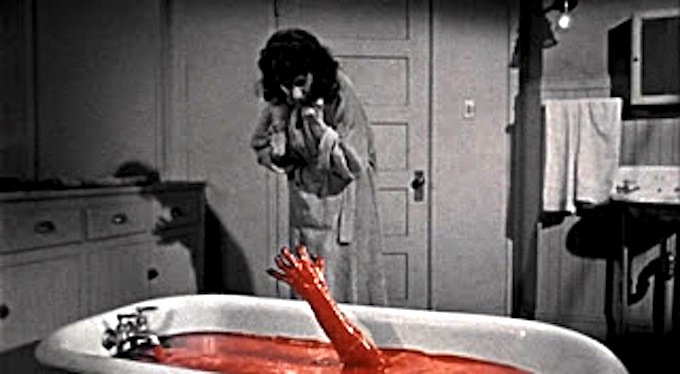

This and other events contribute to scarring her to death. Price uses X-Rays to view the parasite still attached to the dead women's spine and then removes it.
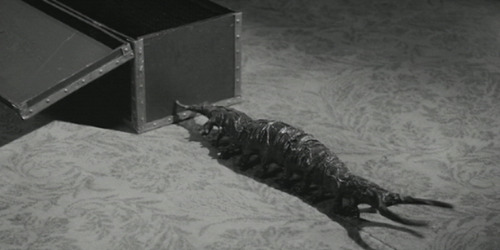
There is a great scene when the black and white film uses a 1950’s trick of turning into color. As the wife prepares for her bath and blood comes out instead of her bath water. Then a hand followed by a skull like being rises from the tub.


This and other events contribute to scarring her to death. Price uses X-Rays to view the parasite still attached to the dead women's spine and then removes it.

So now "WE" have a dead wife
and Price has his “TINGLER”, but “WE”, the expectant audience, has had no
“Percepto” or at least we think not.
Now comes the scene of a group of
people watching a movie at the Silent Movie Theater and the parasite gets loose
in it. All of a sudden I am hearing people in my theater joining the on screen
screaming including the girl next to me. William Castle’s gimmick has struck, but what is
it?


Castle had purchased military
surplus air-plane wing deicers. Which basically consist of a vibrating motor
that by its vibrations cracks the ice off of the wings. He then had them
attached to the underside of some of the seats in theaters showing the picture and you had “Percepto”. As those seats started to vibrate unexpectedly scaring the person in them during the sequence at the Silent Movie Theater.
No there were no electrical shocks as a lot of people reported, but when you’re engaged in a movie and first you hear Vincent Price state:
No there were no electrical shocks as a lot of people reported, but when you’re engaged in a movie and first you hear Vincent Price state:
Scream-scream for your lives!and at that exact moment those vibrators are turned on. Well you can imagine the reaction.
For the theaters that were not
equipped for “Percepto”, that initial run, and again the Drive-Ins. The prologue
with William Castle addressing the audience was edited out. My showing did have
Castle first appear and address the movie audience with:
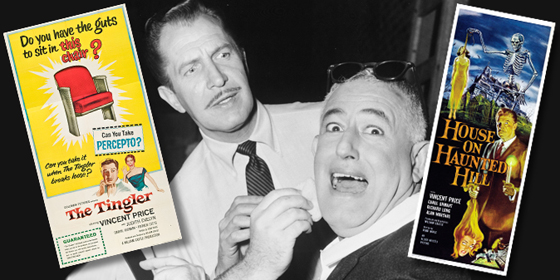
I am William Castle, the director of the motion picture you are about to see. I feel obligated to warn you that some of the sensations—some of the physical reactions which the actors on the screen will feel—will also be experienced, for the first time in motion picture history, by certain members of this audience. I say 'certain members' because some people are more sensitive to these mysterious electronic impulses than others. These unfortunate, sensitive people will at times feel a strange, tingling sensation; other people will feel it less strongly. But don't be alarmed—you can protect yourself. At any time you are conscious of a tingling sensation, you may obtain immediate relief by screaming. Don't be embarrassed about opening your mouth and letting rip with all you've got, because the person in the seat right next to you will probably be screaming too. And remember—a scream at the right time may save your life.

There was no question by July 10,
1960 William Castle was on a roll at least with pre-teens and teens. His
name on a film about the mating habits of the Tsetse Fly would have been a
sellout. So how to top “Emergo” and “Percepto”? Why with “Illusion-O” of
course and the ability to see "13 GHOSTS" in Castle's film miracle of "Ectoplasmic Color".
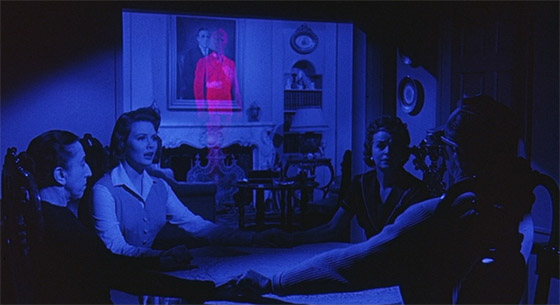

Paleontologist/Teacher "Cyrus
Zorba", Donald Wood, is barely scratching out a living for his wife and two children as their
debts keep mounting. Fate steps in when his forgotten "Uncle Plato Zorba" dies and
leaves him a free house. That appears, at first, as a timely gift for his
family. Oh, but there is one small point "Cyrus" is told by the lawyer handling the Will, "Benjamin Rush", Martin Milner.. His "Uncle Plato" collected
Ghosts and there are 12 living (?) at the house and he inherits them also. "Cyrus" thinks he's joking, but "Rush" tells him the "Ghosts" are his too.
This haunted house also comes with it's own housekeeper that becomes a great running gag from William Castle and his screenplay writer Robb White. White wrote the previous three "Gimmick" picture screenplays. The housekeeper "Elaine Zacharides" was portrayed by Margaret Hamilton. Better known as the "Wicked Witch of the West" from 1939's "The Wizard of Oz". Being in on the joke. Hamilton played the housekeeper, at times, as if she was "The Wicked Witch"
.
 "
"
The gag has young "Buck Zorba", the movies actual top billed star Charles Herbert, thinking "Elaine" actually is a witch. It turns out that the housekeeper is a Medium and a Seance to contact "Plato Zorba" is held. See the blue still above. Below "Cyrus" is wearing the classes left by his "Uncle Plato" to be able to see the ghosts.

Television and movie ads for the feature showed pictures of each of the Ghosts, but used a question mark when the 13th Ghost was reached. As William Castle implied a member of the theater audience might become Number Thirteen.



This haunted house also comes with it's own housekeeper that becomes a great running gag from William Castle and his screenplay writer Robb White. White wrote the previous three "Gimmick" picture screenplays. The housekeeper "Elaine Zacharides" was portrayed by Margaret Hamilton. Better known as the "Wicked Witch of the West" from 1939's "The Wizard of Oz". Being in on the joke. Hamilton played the housekeeper, at times, as if she was "The Wicked Witch"
.
The gag has young "Buck Zorba", the movies actual top billed star Charles Herbert, thinking "Elaine" actually is a witch. It turns out that the housekeeper is a Medium and a Seance to contact "Plato Zorba" is held. See the blue still above. Below "Cyrus" is wearing the classes left by his "Uncle Plato" to be able to see the ghosts.

Television and movie ads for the feature showed pictures of each of the Ghosts, but used a question mark when the 13th Ghost was reached. As William Castle implied a member of the theater audience might become Number Thirteen.



So back my friends I went to the
Van Nuys Theater. When I paid for my ticket I was handed a “Ghost Viewer”.
For those unfamiliar with it, or have not purchased the DVD with one included.
You had two pieces of cellophane with a red one on top to see the Ghosts and if you were too frightened a blue one on the bottom not not see them. A great gimmick.

I read reviews where people refer to the "Ghost Viewer" as if it were like a 3-D pair of glasses. The colors are the same for "Anamorphic 3-D", but with 3-D glasses you need one color over each eye and the glasses are setup like a regular pair. Which of course is not the case with the “Ghost Viewer”.

I read reviews where people refer to the "Ghost Viewer" as if it were like a 3-D pair of glasses. The colors are the same for "Anamorphic 3-D", but with 3-D glasses you need one color over each eye and the glasses are setup like a regular pair. Which of course is not the case with the “Ghost Viewer”.
Castle shot the movie on black
and white film. When any of his cast react to one of the Ghosts. The action was shot against a Blue Screen. Green Screens did not come into use until the 1970's. William Castle then shot his actors portraying the Ghosts on
film tinted blue and superimposed that over the other. When you looked through
the red cellophane the Ghost images were enhanced, but the blue blocked them
out. Yes, because of the blue tint you were able to barely make out the
images without a “Ghost Viewer”.
Another misconception is that
theaters without the viewers showed the same print of the film. This is
incorrect as there was a print once more made specifically for Drive-In’s. That print was also used
after the supply of “Ghost Viewers” finally ran out. That print had the Ghost images more
pronounced for viewing. The DVD for the film contains both versions and you can
see the difference.
I went to a theater, "The Bundy", also long gone from memory, in 1964. The theater was showing "HOUSE ON HAUNTED HILL". "THE TINGLER", "13 GHOSTS" and "MR. SARDONICUS" without the gimmicks. Somehow they had obtained the original version of "13 GHOSTS" with the blue tint. I went to
the concession stand and bought a piece of candy wrapped in red cellophane and
was probably the only person in the audience who could clearly see the them.
I wrote a blog article on two young actors of the 1950's and 1960's Charles Herbert the star of "13 GHOSTS" and Richard Eyer. Best known as the Genie in Ray Harryhausen's 1957 "The 7th Voyage of Sinbad". Their two fateful careers can be read at:
http://www.bewaretheblog.com/2016/06/richard-eyer-and-charles-herbert-child.html

The next film from William Castle was “Psycho” starring Janet Lee and Anthony Perkins. Oops, meant to say his version of Alfred Hitchcock’s “Psycho”. Released one year after the master on July 26, 1961 entitled "HOMICIDAL" with another Robb White screenplay.

The motion picture starred Glenn Corbett, Patricia Breslin and the female Norman Bates “Emily” played by Joan Marshall. However Marshall agreed to be billed as Jean Arless, a French male sounding name, so she could play Warren. To keep Marshall from being recognized on screen. She agreed to have her hair cut into a man’s style and dyed. Along with her facial features being changed by the make-up artist to resemble a man. It worked extremely well. First a photo of the actress in her double role for William Castle and next the actress as she normally looked in 1961. Taken from the "Twilight Zone" episode "Dead Man's Shoes".

I wrote a blog article on two young actors of the 1950's and 1960's Charles Herbert the star of "13 GHOSTS" and Richard Eyer. Best known as the Genie in Ray Harryhausen's 1957 "The 7th Voyage of Sinbad". Their two fateful careers can be read at:
http://www.bewaretheblog.com/2016/06/richard-eyer-and-charles-herbert-child.html

The next film from William Castle was “Psycho” starring Janet Lee and Anthony Perkins. Oops, meant to say his version of Alfred Hitchcock’s “Psycho”. Released one year after the master on July 26, 1961 entitled "HOMICIDAL" with another Robb White screenplay.

The motion picture starred Glenn Corbett, Patricia Breslin and the female Norman Bates “Emily” played by Joan Marshall. However Marshall agreed to be billed as Jean Arless, a French male sounding name, so she could play Warren. To keep Marshall from being recognized on screen. She agreed to have her hair cut into a man’s style and dyed. Along with her facial features being changed by the make-up artist to resemble a man. It worked extremely well. First a photo of the actress in her double role for William Castle and next the actress as she normally looked in 1961. Taken from the "Twilight Zone" episode "Dead Man's Shoes".

This fad of copying Hitchcock was
still going on two years later in 1963 when “The House of Hammer” made
“Paranoiac” with Janette Scott and Oliver Reed doing his best Anthony Perkins.


The gimmick for "HOMICIDAL" was “The Fright
Break”. When a 45-second timer is superimposed over the films climax as Patricia
Breslin approaches the house that the audience knows the sadistic killer was
hiding in and would be finally revealed.

Should you decide you were too frightened. You could proceed to “the Coward’s Corner” of the theater, be escorted out and refunded your ticket price.

To avoid somebody getting refunded and then staying for the next showing of the film. At this time you could stay all day, if you never left the physical theater. Castle had different color tickets printed to be rotated from showing to showing. Over the run of the film it is estimated that about one percent of the audience actually did ask for refunds.

Should you decide you were too frightened. You could proceed to “the Coward’s Corner” of the theater, be escorted out and refunded your ticket price.

To avoid somebody getting refunded and then staying for the next showing of the film. At this time you could stay all day, if you never left the physical theater. Castle had different color tickets printed to be rotated from showing to showing. Over the run of the film it is estimated that about one percent of the audience actually did ask for refunds.
In his book “Crackpot” film critic John Waters wrote this:
William Castle simply went nuts. He came up with 'Coward's Corner,' a yellow cardboard booth, manned by a bewildered theater employee in the lobby. When the Fright Break was announced, and you found that you couldn't take it anymore, you had to leave your seat and, in front of the entire audience, follow yellow footsteps up the aisle, bathed in a yellow light. Before you reached Coward's Corner, you crossed yellow lines with the stenciled message: 'Cowards Keep Walking.' You passed a nurse (in a yellow uniform?...I wonder), who would offer a blood-pressure test. All the while a recording was blaring, "'Watch the chicken! Watch him shiver in Coward's Corner'!" As the audience howled, you had to go through one final indignity -- at Coward's Corner you were forced to sign a yellow card stating, 'I am a bona fide coward.' Very, very few were masochistic enough to endure this. The one percent refund dribbled away to a zero percent, and I'm sure that in many cities a plant had to be paid to go through this torture. No wonder theater owners balked at booking a William Castle film. It was all just too complicated.



Five years later, in 1966, Warner
Brothers released a film entitled “Chamber of Horrors”. The studio did a takeoff
on William Castle’s “Fright Break.” In this case it consisted of a combination
of “The Fear Flasher” and “The Horror Horn”. When the murderer was about to
strike the screen started to flash. This was to warn you to turn away from the gruesome scene about to occur. When the murder was about to perform the actual gruesome act/ The second warning, the horn, sounded. So you could close your eyes.
Actually Castle should have been honored by this film which out "Schlocked" the "Schlock master" himself.
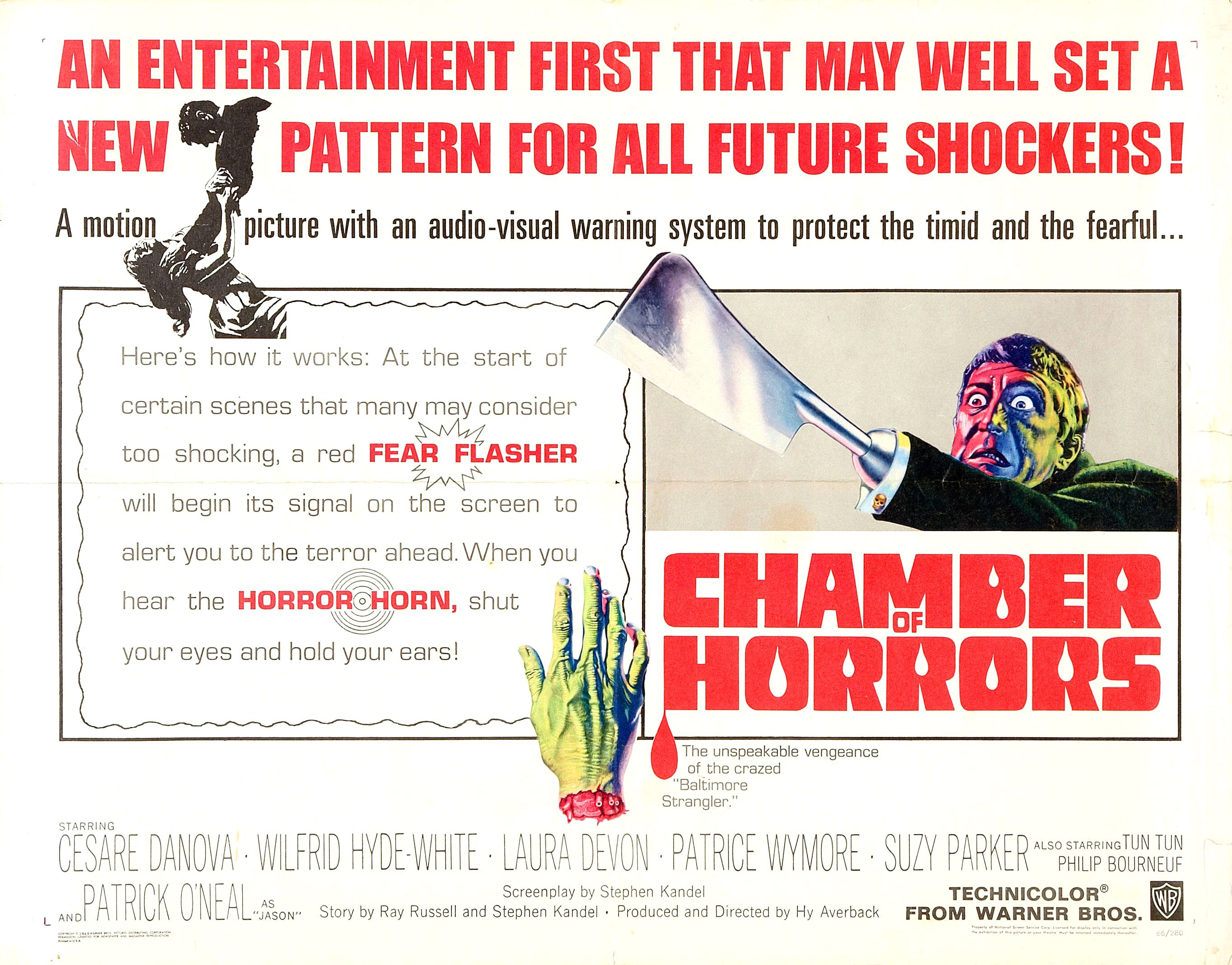
Warner Brothers “Chamber of Horrors” was nothing more than an unsold pilot film for a television series, “The Fear Flasher” and “The Horror Horn” were edited into the pilot at specific points as a gimmick for the theatrical release. The story was about two Sherlock Holmes style hero’s played by Ceasare Danova and Wilfrid Hyde-White that work out of a Wax Museum owned by Hyde-White. The museum was the actual sets both outside and inside from Warner Brother’s 1953 3-D film “House of Wax” starring Vincent Price. The pilot went so far as to keep the name “House of Wax” on the outside of the museum. “The Fear Flasher” and “The Horror Horn” were a great gimmick that worked as there really wasn’t any blood, or gore from a possible 1966 television series, but they created the sense that you had seen something you never did. I own it on DVD.
Actually Castle should have been honored by this film which out "Schlocked" the "Schlock master" himself.

Warner Brothers “Chamber of Horrors” was nothing more than an unsold pilot film for a television series, “The Fear Flasher” and “The Horror Horn” were edited into the pilot at specific points as a gimmick for the theatrical release. The story was about two Sherlock Holmes style hero’s played by Ceasare Danova and Wilfrid Hyde-White that work out of a Wax Museum owned by Hyde-White. The museum was the actual sets both outside and inside from Warner Brother’s 1953 3-D film “House of Wax” starring Vincent Price. The pilot went so far as to keep the name “House of Wax” on the outside of the museum. “The Fear Flasher” and “The Horror Horn” were a great gimmick that worked as there really wasn’t any blood, or gore from a possible 1966 television series, but they created the sense that you had seen something you never did. I own it on DVD.
After watching Castle's "Hitch"movie
I was surprised that three months later he released a second film two days after my 15th birthday on October 18, 1961. “MR. SARDONICUS” was written by Ray Russell. Like many other teens it was obvious that I was hooked on William Castle films. To get to the Reseda theater I did something in 1961 that no parent would let their child do in 2017 Los Angeles. I rode my bike for a solid hour to get to the one movie theater near me showing the picture.
When I paid for my ticket I was
given a glow in the dark card with a picture of a thumb on it. “MR. SARDONICUS”
was billed as:
The Only Picture With ‘The Punishment PollThe card was Castle’s gimmick for the poll.
The movie was about Baron
Sardonicus whose face became frozen in a horrifying grin. It happened while he was robbing his
father’s grave to obtain a winning lottery ticket buried within it.
As a result Sardonicus cannot eat solid foods. He goes in search of a doctor to perform an
operation to correct his face and allow him simply to eat again.


Before I go further in the story. Although the make-up is a little too fake looking. The face of Sardonicus reminded me of Conrad Veidt in the 1928 silent adaptation of Victor Hugo's "The Man Who Laughs".
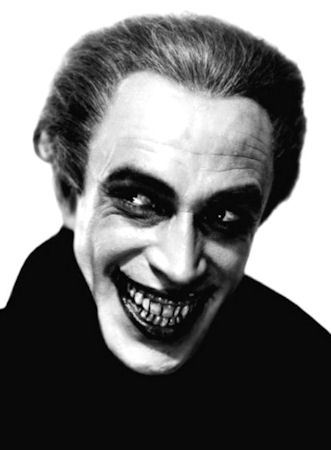
Below Baron Sardonicus wearing a mask to hide his distorted face. I know what my reader is thinking the "Phantom of the Opera".

Before I go further in the story. Although the make-up is a little too fake looking. The face of Sardonicus reminded me of Conrad Veidt in the 1928 silent adaptation of Victor Hugo's "The Man Who Laughs".

Below Baron Sardonicus wearing a mask to hide his distorted face. I know what my reader is thinking the "Phantom of the Opera".
At a point in the film, after the
operation has been performed, the story stops and William Castle walks out to
speak to the audience. He explains that we are to take the card and either hold
it thumbs up, if we want Sardonicus to have a successful operations, or thumbs
down, if we want the operation to be a failure.

He then proceeds to count the votes to determine the result and informs the audience that the ending they voted for would now play. The film resumed and although Baron Sardonicus no longer has the horrifying grin. He discovers he cannot open his mouth at all. Roll closing credits
.
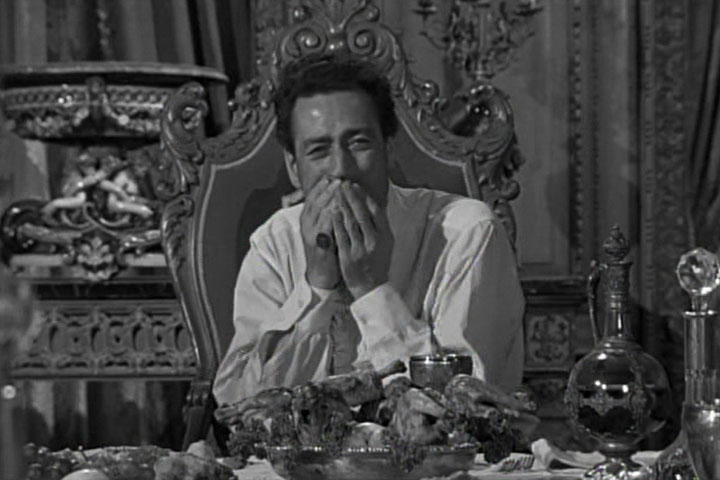
With this motion picture William Castle was able to create a second "Gimmick" with "MR. SARDONICUS" for those seeing his film at a Drive-in theater. A second film was
released with Castle informing those in attendance to flash their cars
headlights a certain way for each of the possible punishments to Baron
Sardonicus.
William Castle has claimed that there were
two versions of the film shot. One with the ending I just described and another
with a merciful ending where Baron Sardonicus is cured. Nobody ever saw the
second version Castle claimed he shot and most of his cast members claim there never was a second ending made.
In response to this criticism William Castle additionally claimed he was made to shoot that “happy ending” by Columbia Studios, but they decided never to release it. What all this could be was simply the "Master Showman" working up the publicity.
On October 3, 1962 William Castle released "ZOTZ". According to the posters:
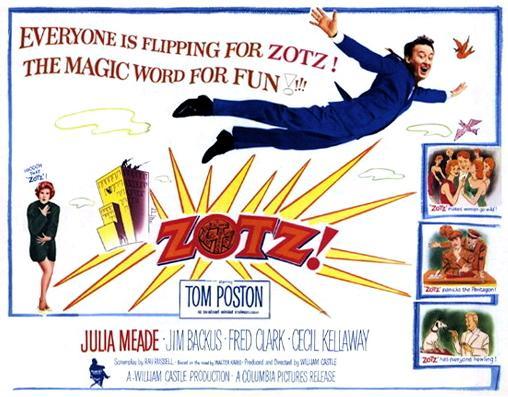
In response to this criticism William Castle additionally claimed he was made to shoot that “happy ending” by Columbia Studios, but they decided never to release it. What all this could be was simply the "Master Showman" working up the publicity.
On October 3, 1962 William Castle released "ZOTZ". According to the posters:
Everyone Is Flipping for Zotz! The Magic Word For Fun.

I paid by admission at the Van
Nuys Theater and was given my own “Plastic” copy of the “ZOTZ” amulet and
entered the theater. The movie starred comedian Tom Poston as "Professor
Jonathan Jones". He's considered an odd ball professor of Ancient Eastern languages, but discovers
that the amulet sent to his niece, by her boyfriend, from an archaeological dig
has magical powers.
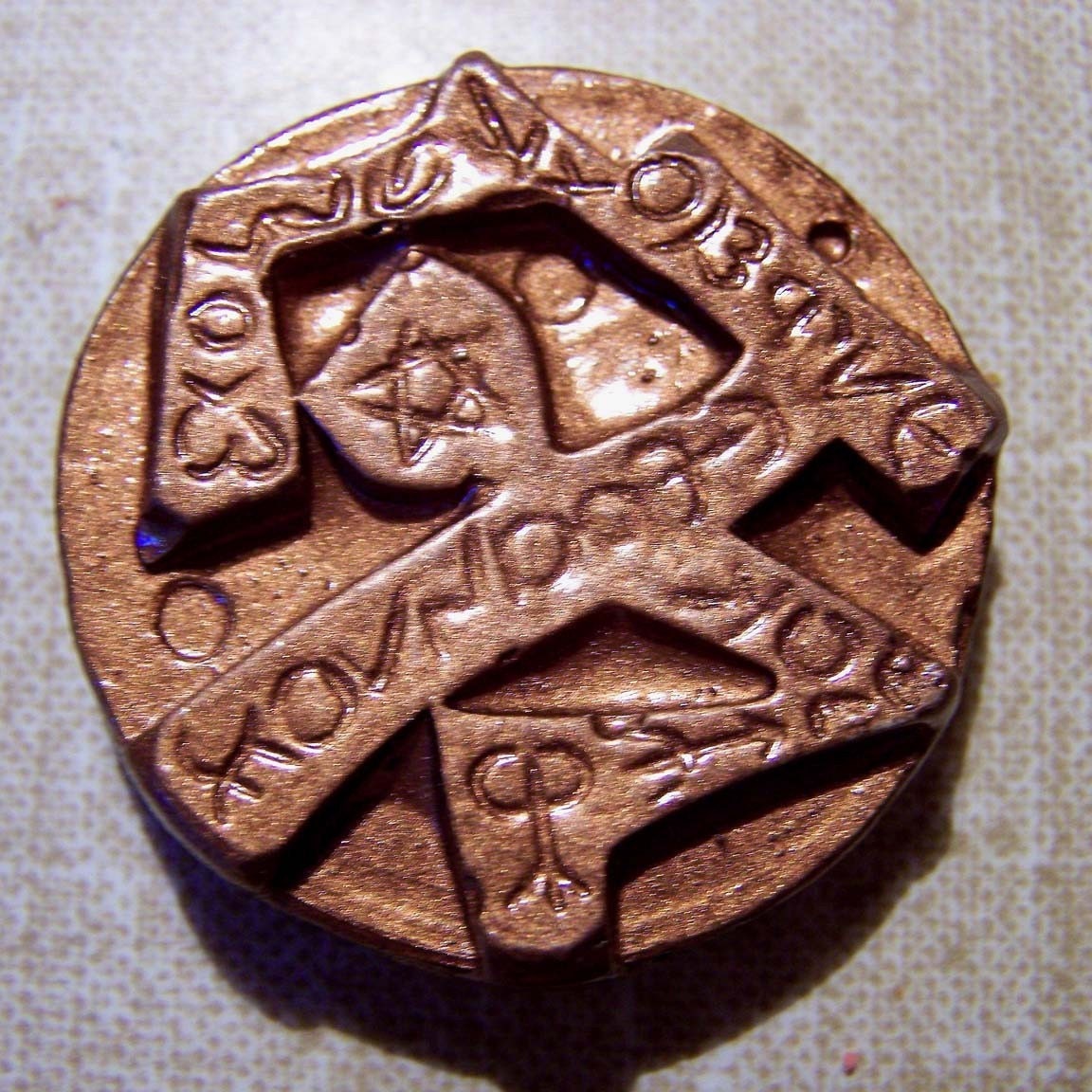

The problem with the movie is
Castle was to obviously ripping off Walt Disney’s “Absent Minded Professor” from
the previous year with Fred MacMurray.

The "Professor Jones" character is a parody of "Professor Ned Brainard". Like the Walt Disney movie. The William Castle picture was supposed to be a comedy, but there is a dark side to “ZOTZ.” Which comes from the original novel by Walter Karig. In the novel the amulet is a metaphor for nuclear weapons and was written two years after the atomic bombs were dropped upon Hiroshima and Nagasaki.

The "Professor Jones" character is a parody of "Professor Ned Brainard". Like the Walt Disney movie. The William Castle picture was supposed to be a comedy, but there is a dark side to “ZOTZ.” Which comes from the original novel by Walter Karig. In the novel the amulet is a metaphor for nuclear weapons and was written two years after the atomic bombs were dropped upon Hiroshima and Nagasaki.
"Professor Jones" translates the
inscription on the amulet and finds he has three powers.
He can inflict pain, slow down time, or kill and this last is certainly not comical. The different powers are triggered by either looking at someone with the amulet in your possession while saying the word “Zotz”, just pointing your finger, or by pointing his finger and saying “Zotz” at the same time resulting in death.
He can inflict pain, slow down time, or kill and this last is certainly not comical. The different powers are triggered by either looking at someone with the amulet in your possession while saying the word “Zotz”, just pointing your finger, or by pointing his finger and saying “Zotz” at the same time resulting in death.
Setting the comic aspect of the
film. It opens with William Castle pointing his finger at the Columbia logo and
saying “Zotz” and the movie begins.
At the end of the film the Columbia logo reappears and says"
At the end of the film the Columbia logo reappears and says"
ZOTZ ALLA play on the Porky Pig endings to the Warner Brothers “Looney Tunes” cartoons:
That’s all folks.
The following Monday I noticed a lot of kids roaming my school pointing their fingers at
each other and saying “Zotz”. William Castle would have loved it, but parents with dead kids might not have agreed. Had those plastic amulets been real.
In 1932 James Whale directed a classic Horror/Comedy motion picture. It featured Boris
Karloff, Melvyn Douglas, Gloria Stuart (the old lady in James Cameron’s “Titantic” and the love interest in Whale's 1933 "The Invisible Man"),
Raymond Massey, Charles Laughton and Ernest Thesiger. Who all just cut loose in “The Old
Dark House”.
%20(lc)%20(ed%2039)%2001.jpg)
In 1963 William Castle attempted to replace James Whale as director of “THE OLD DARK HOUSE” with a cast that included Tom Poston, Robert Morley, and Janette Scott.

Craig Butler of the film database “Allmovie” wrote:
Tom Poston played an American Car Salesman somehow working in London. Who delivers a car to an old mansion located in Dartmoor. He discovers his old school room mate is dead, but is invited by the family to spend the night. Then the fun begins.
%20(lc)%20(ed%2039)%2001.jpg)
In 1963 William Castle attempted to replace James Whale as director of “THE OLD DARK HOUSE” with a cast that included Tom Poston, Robert Morley, and Janette Scott.

Craig Butler of the film database “Allmovie” wrote:
When compared with the James Whale original upon which it is based, this remake of The Old Dark House in pretty sorry stuff.William Castle's picture was made in England and was in association with “Hammer Films”. “The Hammer Story: The Authorized History of Hammer Films” called the movie
one of the oddest pictures Hammer Film Productions ever madebut added that it was also:
strangely endearingI agree with the last. Yes this is not James Whale, but it is very good William Castle.
Tom Poston played an American Car Salesman somehow working in London. Who delivers a car to an old mansion located in Dartmoor. He discovers his old school room mate is dead, but is invited by the family to spend the night. Then the fun begins.
William Castle followed this picture with “13 FRIGHTENED GIRLS” aka: “THE CANDY WEB”.
To begin with should the viewer take the time to count the girls. They will discover there are 15 not 13. Was Castle attempting to play off his successful "13 GHOSTS" title? The alternative title "THE CANDY WEB" comes from the main young lady "Candance 'Candy' Hull" played by unknown Kathy Dunn. Below is the Australian poster for the motion picture. Notice that this poster refers only to 12 girls.
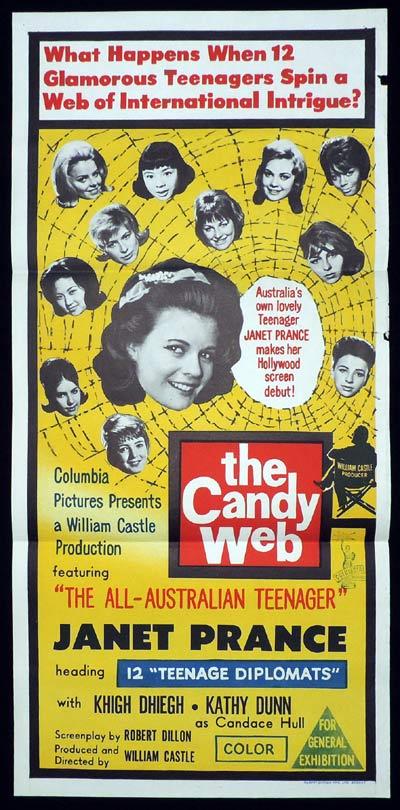
The motion picture was planned as an International Espionage drama about a teenage sleuth. Actually it was a “Gimmick film” of sorts. Castle had a well-publicized worldwide casting hunt:
Castle filmed slightly different versions of the movie giving each girl from the country it was to be shown in a larger part. So if any of you are interested in finding all 13 versions, or is it 15 (?) of this movie to compare. Let me know what you discover was changed each time.


To begin with should the viewer take the time to count the girls. They will discover there are 15 not 13. Was Castle attempting to play off his successful "13 GHOSTS" title? The alternative title "THE CANDY WEB" comes from the main young lady "Candance 'Candy' Hull" played by unknown Kathy Dunn. Below is the Australian poster for the motion picture. Notice that this poster refers only to 12 girls.

The motion picture was planned as an International Espionage drama about a teenage sleuth. Actually it was a “Gimmick film” of sorts. Castle had a well-publicized worldwide casting hunt:
for the prettiest girl’s from 13 different counties.The explanation for the above Australian poster is that "Of Sorts Gimmick" by William Castle.
Castle filmed slightly different versions of the movie giving each girl from the country it was to be shown in a larger part. So if any of you are interested in finding all 13 versions, or is it 15 (?) of this movie to compare. Let me know what you discover was changed each time.


William Castle next produced and
directed the 1964 adult themed “THE NIGHT WALKER” written by “Psycho” author Robert Bloch. A lot of the budget went into the pictures two leads. The motion picture was Barbara Stanwyck's final big screen appearance. The following year found her starring in the television western "The Big Valley". Her co-star in this motion picture was ex-husband Robert Taylor. They had been married from 1939 to 1951.
One of the posters for the film had the tag line:
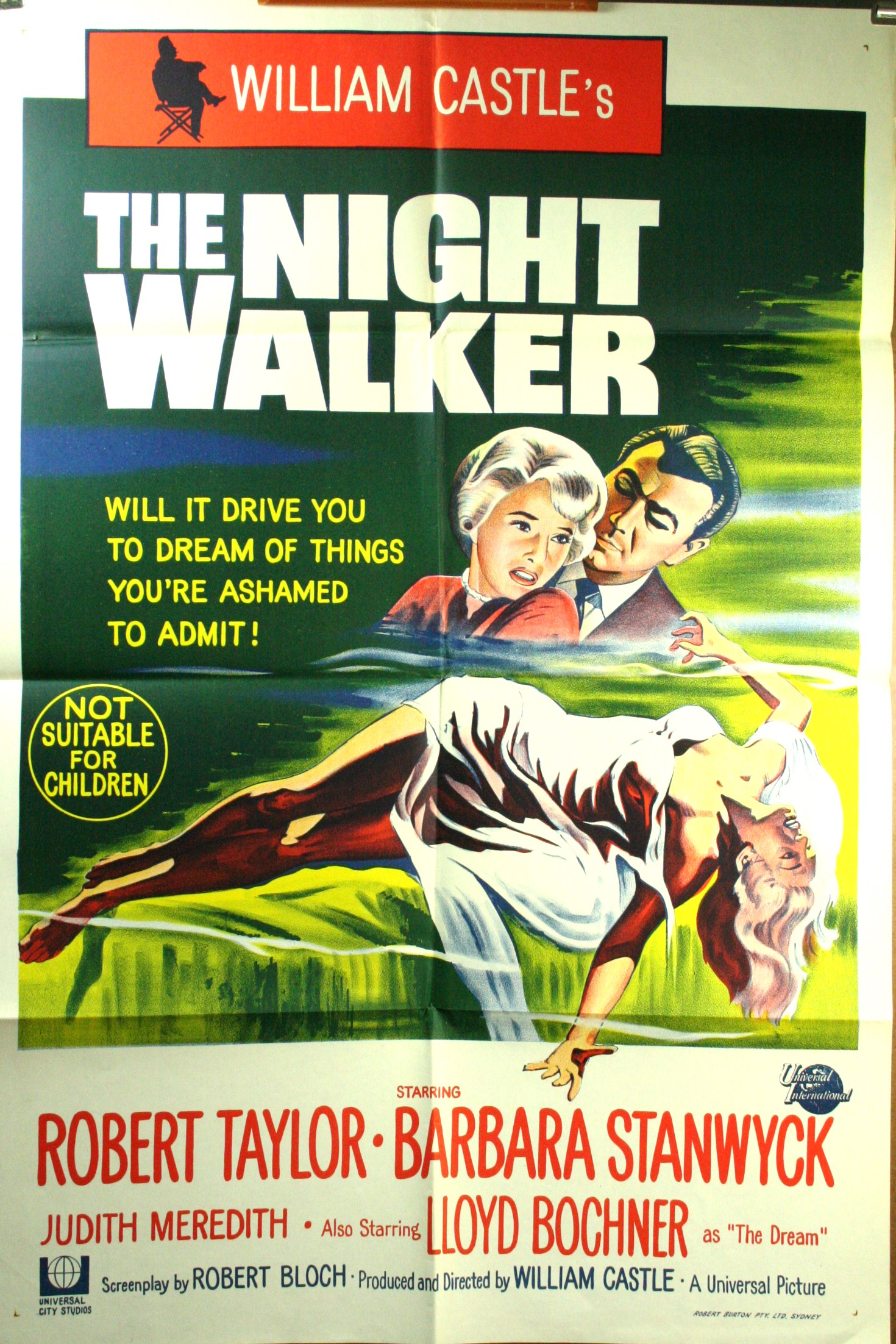
While another poster used a more sexual tag line:
One of the posters for the film had the tag line:
The Night Walker Will It Drive You To Dream Of Things Your’re Ashamed To Admit!

While another poster used a more sexual tag line:
The film is a psychological suspense
film and is actually very good. Stanwyck’s character has some truly weird
dreams and the reality behind them is not revealed until the films end.

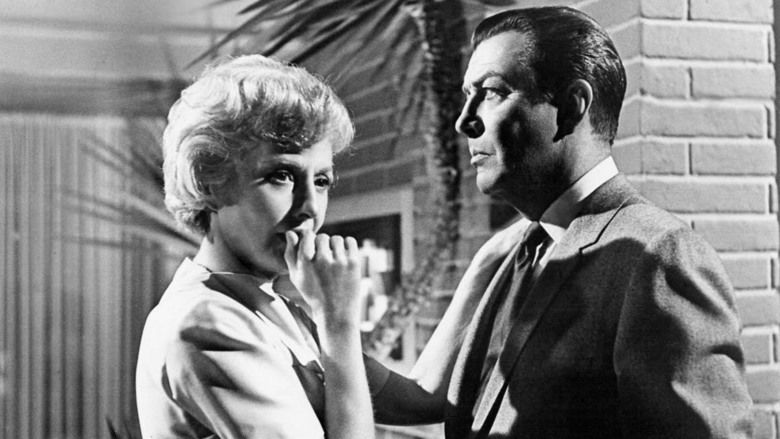

The film wasn’t a financial success. In fact more people where interested in how the ex-married couple of Barbara Stanwyck and Robert Taylor would get along and what Taylor’s current wife, German actress Ursula Thiess, thought of the two together. .



The film wasn’t a financial success. In fact more people where interested in how the ex-married couple of Barbara Stanwyck and Robert Taylor would get along and what Taylor’s current wife, German actress Ursula Thiess, thought of the two together. .
Robert Boch wrote the screenplay
to a second 1964 film “STRAIT-JACKET”. This time William Castle had "Mommie Dearest", herself, Joan Crawford, with the
poster telling us:
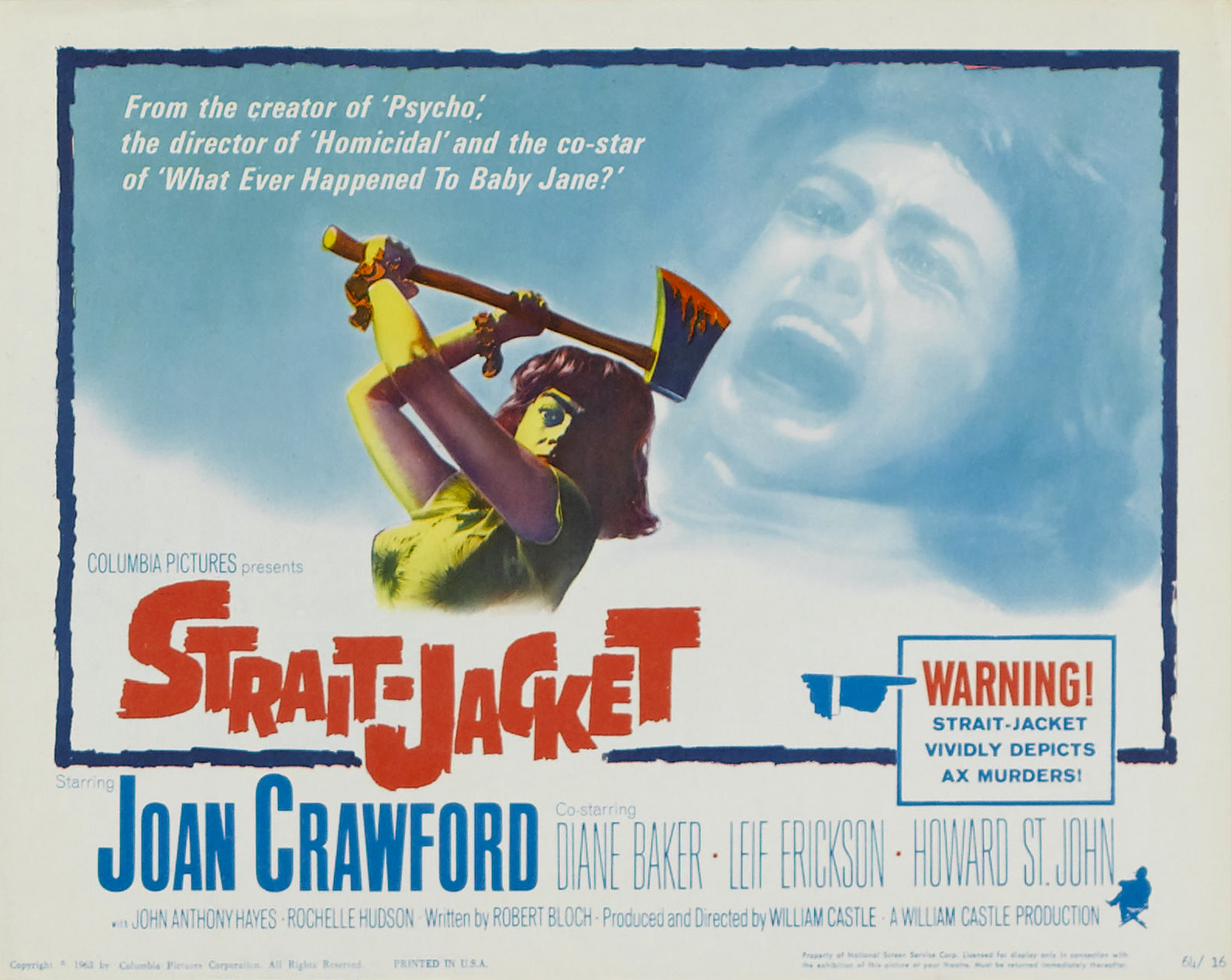
The question is whose the ax murderer? The mother, or THE daughter? Oh, and as you entered the theater you were given your own personal cardboard AX!
Joan Crawford's "Lucy Harbin" has just been released from a psychiatric hospital she's been in for the last 20 years. This was a result of being charged with the decapitation of her husband and his mistress with an Ax. Can you identify the actor portraying the husband in the following photo?
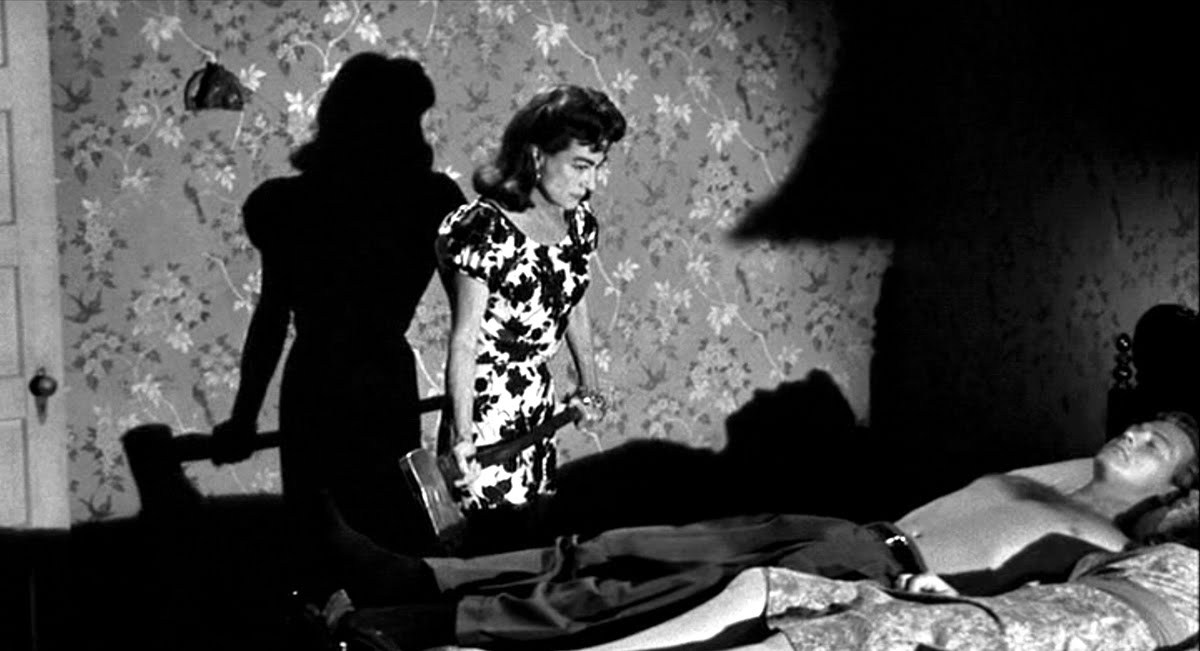
How about from the death heads made to be in Crawford's bed after the decapitation?

From 1965 through 1969 he joined Barbara Stanwyck on "The Big Valley", but was best known from 1974 through 1978 as "The Six Million Dollar Man". Yep, Lee Majors in his first, and non-screen credited, motion picture role. One he just died to get.
Joan Crawford's characters older daughter "Carol" was portrayed by Diane Baker.

WARNING! Strait-Jacket Vividly Depicts Ax Murders!However, it was the other tag line that I loved and demonstrated William Castle's publicity genius:
From the creator of "Psycho,"the director of "Homicidal" and the co-star of "What Ever Happened to Baby Jane?"

The question is whose the ax murderer? The mother, or THE daughter? Oh, and as you entered the theater you were given your own personal cardboard AX!
Joan Crawford's "Lucy Harbin" has just been released from a psychiatric hospital she's been in for the last 20 years. This was a result of being charged with the decapitation of her husband and his mistress with an Ax. Can you identify the actor portraying the husband in the following photo?

How about from the death heads made to be in Crawford's bed after the decapitation?

From 1965 through 1969 he joined Barbara Stanwyck on "The Big Valley", but was best known from 1974 through 1978 as "The Six Million Dollar Man". Yep, Lee Majors in his first, and non-screen credited, motion picture role. One he just died to get.
Joan Crawford's characters older daughter "Carol" was portrayed by Diane Baker.

When I was a kid I admit to
having called people up and saying:
I'll give my reader that old excuse "Everybody did it" at some time while I was growing up. It was this game (?) that became William Castle’s film “I SAW WHAT YOUR DID AND I KNOW WHO YOU ARE" in 1965. Two teenage girls make the mistake of phoning the wrong man who just murdered his wife. The film starred Joan Crawford, John Ireland, at his best as the murder, and Leif Erickson.

This poster carries the tag line:
Shades of "HOMOCIDAL". In the trailer for "I SAW WHAT YOU DID AND I KNOW WHO YOU ARE" William Castle advised his potential audience of special seating in each theater. Seats in that section would have "Seat Belts" installed for those audience members:

I Saw What You Did and I Know Who You Are!
I'll give my reader that old excuse "Everybody did it" at some time while I was growing up. It was this game (?) that became William Castle’s film “I SAW WHAT YOUR DID AND I KNOW WHO YOU ARE" in 1965. Two teenage girls make the mistake of phoning the wrong man who just murdered his wife. The film starred Joan Crawford, John Ireland, at his best as the murder, and Leif Erickson.

This poster carries the tag line:
William Castle Warns You : This movie is about UXORICIDE!To save my readers unfamiliar with the word Uxoricide looking it up. It comes from the Latin and means murdering your wife, or romantic partner. Imagine all the potential audience members that did go to their dictionaries. As of course the Internet didn't exist at the time.
Shades of "HOMOCIDAL". In the trailer for "I SAW WHAT YOU DID AND I KNOW WHO YOU ARE" William Castle advised his potential audience of special seating in each theater. Seats in that section would have "Seat Belts" installed for those audience members:
Who might be scared out of their seats.The idea was dropped prior to the actual film's release.

Castle would direct and produced four more films each of lessening quality within the next three years. "LETS KILL UNCLE", 1966, "THE BUSY BODY", 1967, "THE SPIRIT IS WILLING", 1967 and "PROJECT X", 1968.
Which brings me to a 1968 film he wanted to produce and direct very much.
The story goes that William Castle wanted to direct a prestigious film an obtained the movie rights to novelist Ira Levin’s next novel. Even before Levin started to write it. The book was a major hit and Castle started to put together a deal with Paramount Pictures to film and release “ROSEMARY'S BABY”.
However, Paramount insisted on another director Roman Polanski and William Castle had to settle for producer. However, he did do an Alfred Hitchcock. He is seen as the grey-haired man standing outside the phone booth where "Rosemary", Mia Farrow, is attempting to contact her obstetrician.
This psychological horror story, with Polanski writing the screenplay, is a recognized classic about a Satanic cult and the birth of the Devil's child. Also it makes you wonder about those kind neighbors in your apartment house.
Which brings me to a 1968 film he wanted to produce and direct very much.
The story goes that William Castle wanted to direct a prestigious film an obtained the movie rights to novelist Ira Levin’s next novel. Even before Levin started to write it. The book was a major hit and Castle started to put together a deal with Paramount Pictures to film and release “ROSEMARY'S BABY”.
However, Paramount insisted on another director Roman Polanski and William Castle had to settle for producer. However, he did do an Alfred Hitchcock. He is seen as the grey-haired man standing outside the phone booth where "Rosemary", Mia Farrow, is attempting to contact her obstetrician.
This psychological horror story, with Polanski writing the screenplay, is a recognized classic about a Satanic cult and the birth of the Devil's child. Also it makes you wonder about those kind neighbors in your apartment house.
“ROSEMARY"S BABY” would be
followed by three more feature films. In which William Castle would direct one, "SHANKS", 1974, and produced two, "RIOT", 1969 starring Jim Brown and Gene Hackman, and "BUG", 1975.
William Castle's last film was an acting role in director John Schlesinger’s 1975 “THE DAY OF THE LOCUST” about 1930's Hollywood. The film had William Castle portraying a director named "William C. Castle". That fictional "William Castle" is making an epic about the battle of Waterloo. When as the cameras roll the set collapses on the extras. Perhaps a metaphor for his own career at that time.
William Castle's last film was an acting role in director John Schlesinger’s 1975 “THE DAY OF THE LOCUST” about 1930's Hollywood. The film had William Castle portraying a director named "William C. Castle". That fictional "William Castle" is making an epic about the battle of Waterloo. When as the cameras roll the set collapses on the extras. Perhaps a metaphor for his own career at that time.
On May 31, 1977
William Castle died of a heart attack in Los Angeles. His daughter Terry carried on his tradition with remakes of both “House on Haunted Hill”, 1999, and “13
Ghosts”, 2001, for a new generation.

While I enjoyed both of Terry Castle and her associates motion pictures. They reflect the change from a simpler time. When her father could use the audience's imagination and subtle imagery to create horror. To a need to show graphic violence to get the same basic effect. My age is showing.

While I enjoyed both of Terry Castle and her associates motion pictures. They reflect the change from a simpler time. When her father could use the audience's imagination and subtle imagery to create horror. To a need to show graphic violence to get the same basic effect. My age is showing.









